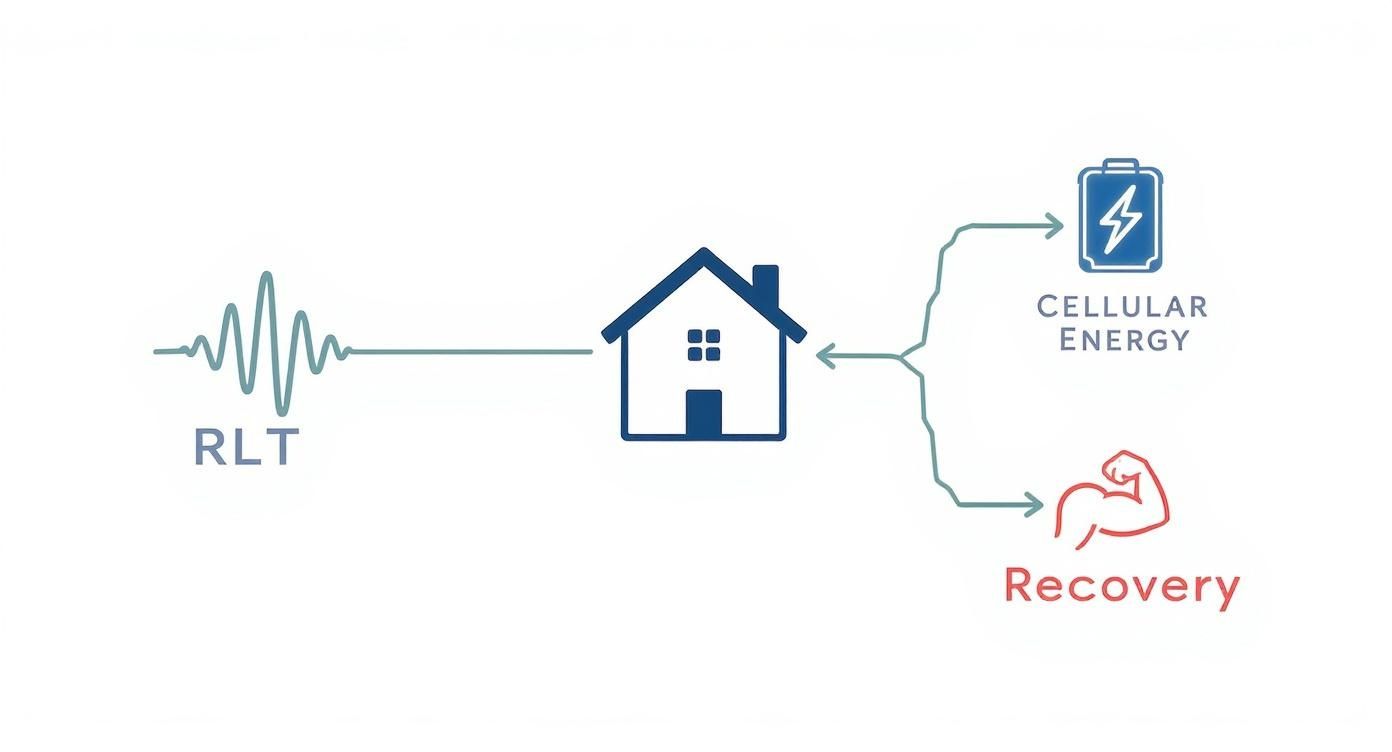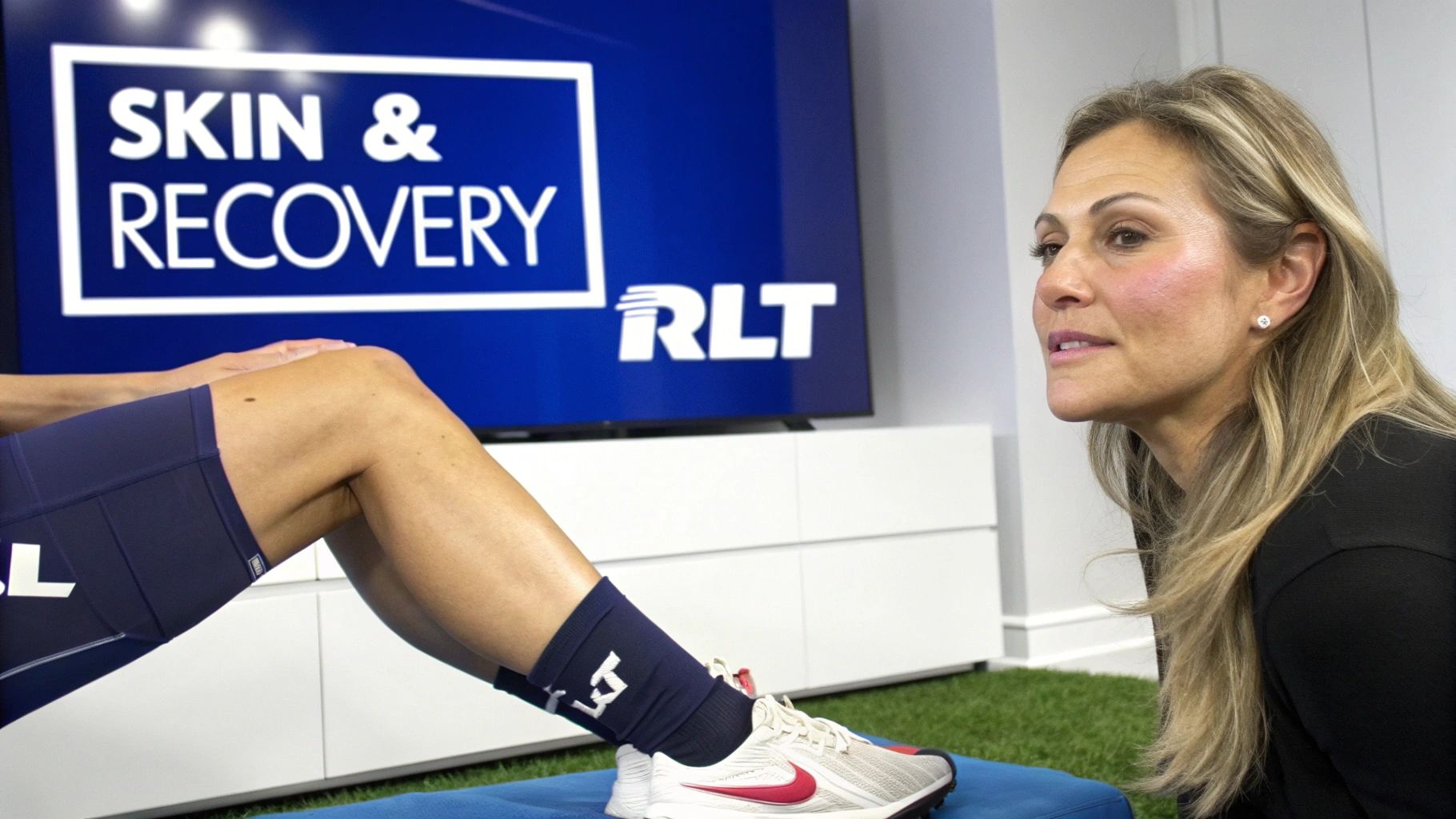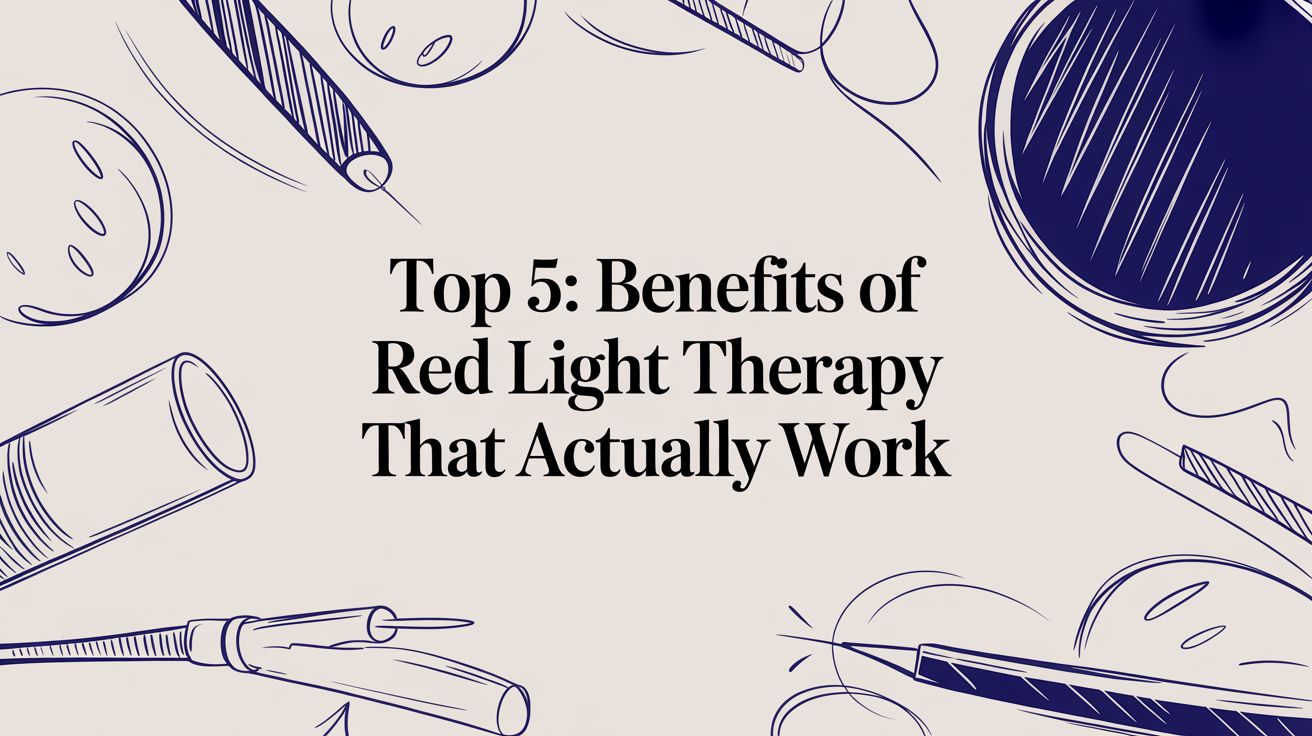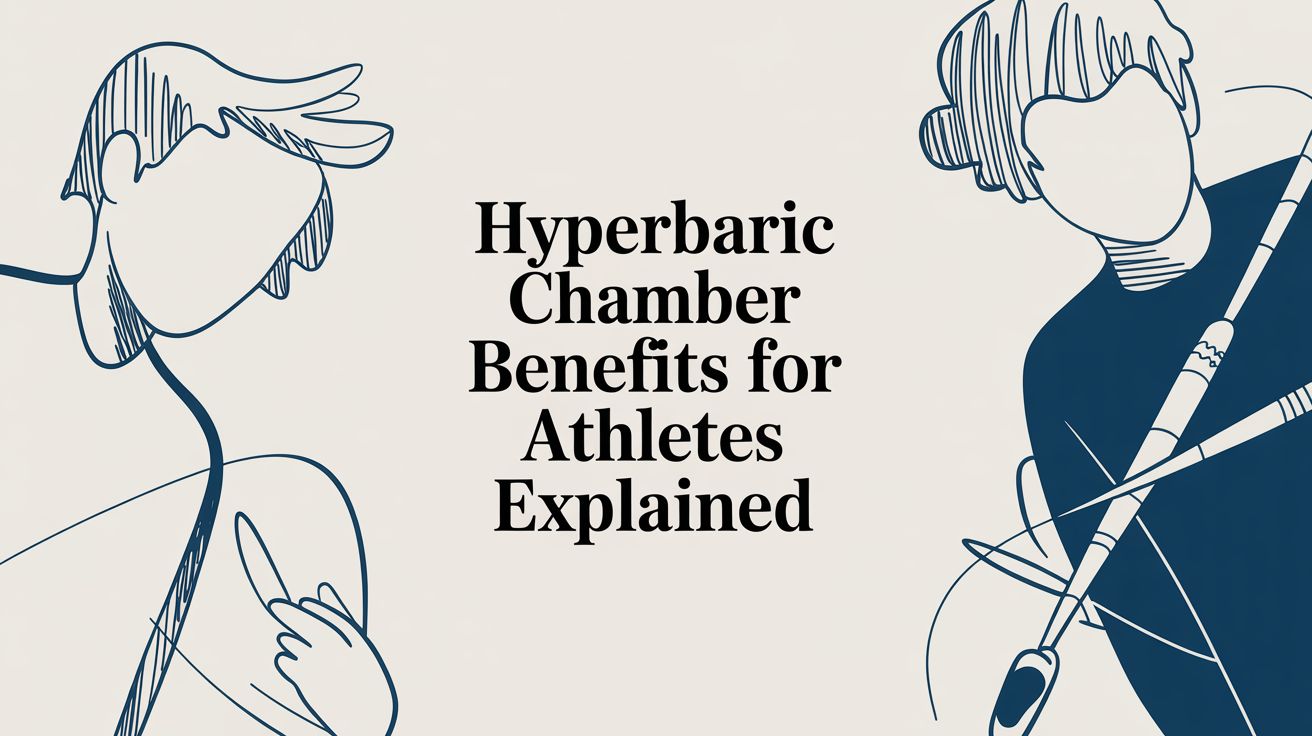
Red Light Therapy at Home for Total Wellness
What if you could harness specific frequencies of light to recharge your body's cells, enhancing your overall well-being right from the comfort of your home? That’s the foundational principle behind red light therapy at home, a wellness practice that has transitioned from exclusive clinics into the daily health routines of individuals committed to proactive self-care.
Bringing Wellness Home with Red Light Therapy
Red light therapy (RLT), known in scientific communities as photobiomodulation, is a remarkably simple yet powerful concept. It utilizes specific wavelengths of red and near-infrared (NIR) light to stimulate your body’s natural healing and cellular regeneration processes. This is not the damaging UV light from the sun; RLT is a gentle, therapeutic light designed purely to promote health and wellness.
The easiest way to understand it is to think of it as photosynthesis for your body. Just as plants absorb sunlight to create energy and thrive, your cells can absorb these specific wavelengths of light. This absorption directly energizes the mitochondria—the powerhouses within our cells responsible for producing cellular fuel.
A Modern Approach to Cellular Health
When you enhance cellular energy, you unlock a wide spectrum of health benefits that support your body’s vitality. This is more than a fleeting wellness trend; it represents a fundamental shift towards empowering individuals with tools to proactively manage their own health. The positive effects are systemic, influencing everything from skin vitality to muscle recovery and pain management.
Here are a few key health and wellness benefits where red light therapy at home truly excels:
- Skin Rejuvenation: It promotes collagen synthesis, which helps diminish the appearance of fine lines and improves your skin’s overall tone and texture for a more youthful glow.
- Enhanced Muscle Recovery: It’s a game-changer for reducing post-exercise soreness and accelerating the repair of muscle tissue, allowing you to return to your activities faster.
- Pain and Inflammation Relief: RLT provides a non-pharmacological method for managing joint pain and calming inflammation throughout the body, improving comfort and mobility.
- Improved Circulation: It supports better blood flow, which is essential for delivering oxygen and nutrients required for healing and overall vitality.
The core principle is simple: improved cellular function leads to better overall health and wellness. When your cells are energized and operating at peak efficiency, your body can repair itself, combat inflammation, and maintain a state of balance more effectively.
The surge in popularity of at-home devices reflects a broader movement towards accessible and effective wellness technologies. As more people experience the benefits firsthand, the market continues to expand. In fact, home-use devices are a dominant force in the industry, which is projected to reach USD 620 million by 2032.
This guide will illuminate the science behind red light therapy at home, explore the proven health benefits, and provide practical steps for integrating it into your wellness lifestyle. For those creating a complete recovery sanctuary, a dedicated light table can elevate your routine to a professional level.
How Red Light Therapy Recharges Your Cells
To truly appreciate why red light therapy at home is so beneficial for your health, we must look beyond the surface to what happens at a cellular level. It isn't magic—it's advanced biology. Think of it as a cellular recharge, where specific wavelengths of light trigger your body’s natural energy production cycle.
Your body is composed of trillions of cells, and within each one are tiny power plants called mitochondria. Their primary function is to create adenosine triphosphate (ATP), the energy currency that powers every biological process, from muscle contraction to tissue repair.
When you expose your body to therapeutic wavelengths of red and near-infrared light, that light energy penetrates the skin and is absorbed by the mitochondria. This absorption excites key molecules, initiating a cascade of reactions that significantly boosts ATP production.
In essence, red light therapy acts like a high-speed charger for your cells. The resulting surge in ATP provides the energy they need to repair tissue, reduce inflammation, and function at their optimal level.
The Power of Specific Wavelengths
Not just any light will produce these health benefits. The effectiveness of RLT depends on using precise wavelengths, as different wavelengths penetrate to different depths and elicit different biological responses. The most effective devices combine two key therapeutic ranges.
Here is a breakdown of the two most proven wavelengths for wellness:
- Red Light (around 660nm): This wavelength is shorter, allowing it to work its magic closer to the skin's surface. It is ideal for skin health—stimulating collagen, accelerating wound healing, and improving skin texture.
- Near-Infrared Light (around 850nm): This wavelength is longer and invisible to the human eye. It penetrates deeper, reaching muscles, joints, and even bone. It is the preferred wavelength for reducing inflammation, soothing deep aches, and promoting significant tissue recovery.
The true therapeutic power comes from using these two wavelengths in synergy. This combination is what makes red light therapy at home such a versatile wellness tool, capable of addressing everything from skin complexion to post-workout recovery.
This infographic illustrates how at-home wellness practices like red light therapy directly link to cellular energy and physical health.

The visualization shows that by starting at home, RLT directly enhances cellular energy, which in turn fuels the body's entire system for recovery and health.
Upgrading Your Cellular Function
This enhancement of cellular energy creates a positive ripple effect throughout the body. When your cells are abundant with ATP, they repair damage more efficiently, replicate correctly, and build a stronger defense against oxidative stress—a key driver of aging and chronic conditions.
So, when you notice clearer skin, experience less joint pain, or recover from a workout more quickly, you know it's not a superficial fix. It is the result of a fundamental improvement in your cellular health—a true "from the inside out" approach to feeling and functioning at your best.
Once you understand how red light therapy works on a cellular level, the exciting part is seeing those effects translate into real-world results. Consistent red light therapy at home can deliver a huge range of benefits, from skin rejuvenation to deep physical relief. It's an incredibly versatile tool because it operates at a fundamental level, giving your body the resources it needs to heal and perform better.
This isn't just a niche trend. The global light therapy market, valued at USD 1.16 billion, is expected to hit USD 1.66 billion by 2034. Red light therapy is a massive driver of that growth, commanding about 36% of the market share thanks to its proven impact on skin health, inflammation, and muscle recovery.

This table breaks down some of the most common applications for at-home RLT and the specific outcomes you can expect.
Key Health Benefits of At-Home Red Light Therapy
| Application Area | Primary Benefit | Target Wavelengths |
|---|---|---|
| Skin Rejuvenation | Increased collagen production, reduced fine lines & wrinkles | Red (660nm) |
| Pain & Inflammation | Reduced joint stiffness and chronic pain, less swelling | Near-Infrared (850nm) |
| Muscle Recovery | Faster repair, reduced soreness (DOMS), enhanced performance | Red & Near-Infrared |
| Sleep & Mood Support | Regulation of circadian rhythm, potential mood improvement | Red Light |
As you can see, combining different wavelengths allows you to address multiple goals at once, making it a powerful and efficient addition to any wellness routine.
Promoting Youthful Skin and Vitality
One of the most celebrated health benefits of red light therapy is its incredible effect on skin vitality. As we age, the production of collagen and elastin—the proteins responsible for firm, supple skin—naturally declines. Red light, particularly around the 660nm wavelength, penetrates the skin to energize the fibroblast cells that produce these essential proteins.
This process effectively revitalizes your skin's natural repair mechanisms to:
- Reduce the appearance of fine lines and wrinkles by rebuilding the skin’s underlying supportive structure.
- Improve skin tone and texture, contributing to a smoother, more radiant complexion.
- Minimize hyperpigmentation and age spots by promoting cellular turnover and reducing inflammation.
This is a true inside-out approach to skin health. Unlike topical creams that only treat the surface, RLT helps your body build healthier, more resilient skin from its foundation.
Managing Pain and Reducing Inflammation
For individuals dealing with chronic pain or joint stiffness, at-home red light therapy can be a transformative wellness tool, offering a non-invasive, drug-free path to relief. Near-infrared (NIR) light, typically around 850nm, penetrates deeper than red light, reaching muscles, joints, and connective tissues to reduce inflammation at its source.
By enhancing circulation and calming inflammatory pathways, RLT can effectively soothe discomfort from conditions like knee osteoarthritis and low back pain. It is an invaluable tool for managing daily aches and improving mobility without reliance on long-term medication.
The concept is simple: when your cells are energized, they can manage inflammation more effectively. At the same time, increased blood flow brings more oxygen and nutrients to the area, speeding up the body's natural healing process.
Accelerating Muscle Recovery and Performance
Athletes and fitness enthusiasts are rapidly adopting red light therapy at home to gain a competitive edge in their recovery. Intense exercise creates micro-tears in muscle fibers, leading to soreness and fatigue. RLT accelerates the repair of this tissue, enabling you to recover faster and perform at a higher level.
Integrating RLT into your fitness routine can lead to significant performance benefits:
- Less Delayed Onset Muscle Soreness (DOMS), so you can move comfortably after a strenuous workout.
- Faster Muscle Repair and Growth by supplying the cellular energy (ATP) required for rebuilding tissue.
- Improved Blood Flow to muscles, which helps clear metabolic byproducts like lactic acid more efficiently.
Adding a red light session to your post-workout protocol can dramatically shorten your recovery time, meaning less downtime and more progress towards your fitness goals.
Supporting Better Sleep and Mood
Beyond its physical benefits, RLT is also emerging as a powerful tool for improving sleep quality and supporting a balanced mood. Exposure to specific wavelengths of light helps regulate your circadian rhythm—your body’s internal clock that governs sleep-wake cycles.
A calming red light session in the evening can signal to your body that it’s time to wind down, promoting deeper, more restorative sleep. Furthermore, by reducing systemic inflammation and pain—factors that often disrupt sleep and contribute to low mood—RLT helps create an internal environment that supports overall well-being. The research in this area is growing, and the results are incredibly promising for holistic health.
You can dive deeper into the science behind these outcomes in our in-depth guide on the benefits of red light therapy.
How to Choose the Right At-Home RLT Device

Embarking on your journey with red light therapy at home can feel overwhelming. With a vast array of panels, wands, and beds all making bold claims, it’s challenging to determine which devices deliver real health benefits.
The reality is, not all devices are created equal. Making an informed choice is the difference between investing in your wellness and acquiring an expensive gadget. To achieve the desired health outcomes, you need a device that delivers the right kind of light at the proper intensity. Let's break down the essential factors.
Wavelengths and Irradiance: The Two Metrics That Count
Disregard the marketing jargon. The two most critical specifications for any RLT device are wavelengths and irradiance.
Wavelength, measured in nanometers (nm), indicates the specific color of light and, consequently, its therapeutic function. For tangible health benefits, you need a device that operates within the scientifically validated "therapeutic window."
Look for a combination of these two key ranges:
- Red Light (630nm - 660nm): This is the ideal range for skin health. It works closer to the surface to boost collagen, reduce fine lines, and accelerate healing.
- Near-Infrared Light (810nm - 850nm): These invisible wavelengths penetrate much deeper, targeting muscles, joints, and connective tissue to combat inflammation and speed up recovery.
Next is irradiance, the measure of light's power density (mW/cm²). Think of it as the force of the light energy. A weak stream of water has little effect, but a high-pressure jet can clean a surface effectively. The same principle applies to light energy.
An effective red light therapy device must deliver an irradiance of at least 100 mW/cm² at the treatment distance. Any less, and the light simply won't have enough power to penetrate tissues and trigger a meaningful biological response in your cells.
A device can have perfect wavelengths, but if its power output is too low, that energy will dissipate before it can provide any therapeutic benefit. Always verify this specification with the manufacturer—it is a non-negotiable factor for effectiveness.
Comparing Different Device Types
The at-home RLT market is experiencing significant growth. The red light therapy bed market alone was valued at USD 500 million and is projected to grow 15% annually to reach USD 1.8 billion. This growth means more options, so let’s find the right fit for your wellness goals.
- Handheld Wands: These are excellent for targeted treatments on small areas, such as a sore joint, a specific facial area, or a minor muscle strain. They are portable but impractical for larger body parts.
- Small Panels: A solid choice for many users. Tabletop or mountable panels can effectively treat the face, neck, or lower back. They offer much better coverage than wands and serve as a great entry point.
- Full-Body Panels: For serious athletes or anyone seeking systemic health benefits, large, freestanding panels are the gold standard. They can treat the entire body simultaneously, making them highly efficient for comprehensive wellness and post-workout recovery. For a true professional-grade solution, the VitalGlow Professional 360 Multi-Spectrum Red Light Therapy System is designed for exactly this kind of comprehensive coverage.
Key Safety and Quality Indicators
Finally, do not overlook safety and build quality. A reputable device will be transparent about its specifications and certifications. These are markers of a product you can trust for your health.
Look for these three essentials:
- FDA Clearance: This indicates that the FDA has reviewed the device and determined it to be low-risk and substantially equivalent to other legally marketed devices. It is a fundamental safety benchmark.
- Low EMF Output: All electronic devices emit electromagnetic fields (EMF). High-quality RLT panels are engineered to minimize EMF output, ensuring your session is purely therapeutic.
- Third-Party Testing: The best brands substantiate their claims with proof. Independent lab reports that verify wavelength accuracy and irradiance levels are a strong indicator of quality and transparency.
By focusing on these core factors—wavelength, irradiance, device type, and safety—you can navigate the market with confidence and select a red light therapy at home device that delivers real, measurable health benefits.
Getting Started with Your First RLT Session
https://www.youtube.com/embed/nNdBDPXIvSc
You’ve chosen your device and are ready to begin your red light therapy at home wellness journey. The process is straightforward, and establishing a consistent, safe protocol from the start is the key to unlocking the most effective health benefits.
This guide will walk you through everything you need for a successful session, from skin preparation to building a routine that fits your lifestyle. By understanding the key variables—duration, distance, and frequency—you can confidently use your device to achieve your wellness goals.
Simple Pre-Session Preparation
A small amount of preparation can significantly enhance the effectiveness of your treatment. The primary goal is to remove any barriers that could block or reflect the light, ensuring maximum absorption into your skin and underlying tissues.
Always start with clean, dry skin. A quick wash with a gentle cleanser removes any dirt, oil, or cosmetics that could impede light penetration. It is also crucial to avoid applying lotions, creams, or sunscreens immediately before a session, as these can interfere with the therapeutic light. For optimal results, the treatment area should be completely bare.
Mastering Your Treatment Parameters
Consistency and precision are the cornerstones of effective red light therapy. Three key variables determine the efficacy of each session. Mastering these will set you up for success.
Here are the core settings to establish:
- Session Duration: Most protocols recommend 10 to 15 minutes per treatment area. This duration is considered the therapeutic sweet spot for delivering an effective dose of light energy without over-treating.
- Distance from the Device: Position yourself 6 to 12 inches away from the panel. This distance ensures you receive a strong, even intensity (irradiance) across the entire target area.
- Treatment Frequency: Consistency is more important than intensity. For general wellness, 3 to 5 sessions per week is an excellent target. For acute issues like injury recovery, daily use may be beneficial, but it's always important to listen to your body's response.
A crucial pro-tip: 'more' is not always 'better' with red light therapy. Over-treatment can lead to diminished benefits due to a phenomenon called the biphasic dose response. Adhering to the guidelines ensures your cells receive the optimal amount of energy.
Sample Protocols for Common Goals
While the fundamental principles remain the same, you can tailor your sessions to achieve specific wellness objectives. These sample protocols provide a great starting point for your red light therapy at home routine.
Example Treatment Plans:
| Goal | Target Area | Duration | Distance | Frequency |
|---|---|---|---|---|
| Facial Rejuvenation | Face and Neck | 10 minutes | 12-18 inches | 4-5 times per week |
| Post-Workout Recovery | Sore Muscle Groups | 15 minutes per area | 6-12 inches | Daily, post-exercise |
| Joint Pain Relief | Affected Joint | 15 minutes | 6-10 inches | 5-7 times per week |
Starting with a structured plan removes the guesswork from your initial weeks. As you become more attuned to your body's response, you can adjust these parameters to meet your unique needs, making at-home RLT a truly personalized and powerful component of your health and wellness toolkit.
Is Red Light Therapy Safe? Getting it Right at Home
Red light therapy has an excellent safety profile, but like any powerful wellness tool, proper use is key to unlocking its benefits safely and effectively. Following a few simple principles will ensure every session contributes positively to your health.
The most important concept to understand is the biphasic dose response. It sounds technical, but the principle is simple: there's a "sweet spot." Think of it like watering a plant—too little water and it wilts, but too much and you can drown the roots. Red light therapy operates similarly. An insufficient dose has no effect, while an excessive dose can negate the benefits.
Here's the key takeaway: with red light therapy, more isn't better. Sticking to the recommended 10-15 minute sessions is crucial. This gives your cells the perfect amount of energy without causing them to become fatigued.
A Few Simple Precautions
Although the light from RLT devices is not the same as damaging UV rays from the sun, common sense precautions are always wise. Your device likely included protective eyewear. It's a good practice to use it, particularly if you find bright light to be intense.
Additionally, ensure your skin is clean and dry before each session. Lotions, creams, or sunscreens can create a barrier that prevents the light from reaching its target, which diminishes your results and undermines your wellness efforts.
When to Check With Your Doctor
While at-home red light therapy is safe for most people, there are certain situations where consulting with a healthcare professional first is the best course of action. Your health is a collaborative effort.
Please consult your doctor before starting if any of these apply to you:
- Pregnancy: There is limited research on RLT during pregnancy, so it is advisable to err on the side of caution and postpone use.
- Photosensitivity: If you have a medical condition or take medications that increase your skin's sensitivity to light, professional guidance is necessary.
- Active Cancer: Individuals with active cancerous lesions should avoid using RLT over those areas and always consult their oncologist before beginning any new therapy.
By following these straightforward guidelines, you can confidently and safely make red light therapy at home a valuable and reliable part of your wellness routine.
A Few Common Questions About At-Home RLT
Embarking on a red light therapy at home regimen often brings up a few final questions. Having clear, concise answers can make all the difference as you integrate this new practice into your wellness routine. Let's address some of the most common inquiries to help you begin with complete confidence.
A great place to start is managing expectations. The results you experience, and their timeline, will depend on your specific health goals and your consistency.
How Long Until I See Results?
Patience is a key component of the process, as different health benefits manifest on different timelines. You may feel acute benefits—such as temporary pain relief or reduced muscle soreness after a workout—almost immediately or within the first few sessions. This is due to the immediate energy boost to your cells, which helps reduce inflammation quickly.
In contrast, more significant changes like skin rejuvenation require a longer-term commitment. Visible improvements such as firmer skin and a reduction in fine lines are the result of your body's increased collagen production, a process that unfolds gradually over several weeks or months of consistent use.
Can I Use Red Light Therapy Every Day?
This is an excellent question that relates back to the key concept of the biphasic dose response. Remember, there's an optimal "sweet spot" for achieving the best results.
For specific goals, such as managing acute pain or accelerating recovery from intense daily training, a daily session can be highly beneficial. It provides a constant supply of cellular energy precisely when your body needs it most.
For general wellness or skin health, aiming for 3 to 5 sessions per week is typically the most effective frequency. This rhythm allows your cells adequate time to respond to the light therapy without becoming overloaded, ensuring you maximize the health benefits of your red light therapy at home routine.
Should My Skin Be Bare During Treatment?
Yes, absolutely. For the therapeutic light to be effective, it needs a direct, unobstructed path to your cells. Any barrier, no matter how sheer, can reflect or absorb the light waves, significantly reducing the efficacy of your session.
To achieve the best health outcomes, always begin with clean, dry skin. This means no lotions, sunscreens, or makeup on the treatment area. Direct exposure is the only way to ensure the maximum amount of light energy penetrates your skin and reaches the underlying tissues.
Finally, a common question is about RLT's role in body composition. While it is not a weight-loss device, it is a powerful supportive tool for any fitness journey. It enhances your efforts by improving muscle recovery, reducing exercise-induced inflammation, and boosting cellular energy, which allows you to train more effectively and consistently.
Ready to integrate the power of professional-grade recovery into your daily routine? Explore the full range of science-backed wellness equipment at MedEq Fitness and find the perfect tools to elevate your health. Visit us at https://www.medeqfitness.com to get started.
Article created using Outrank


